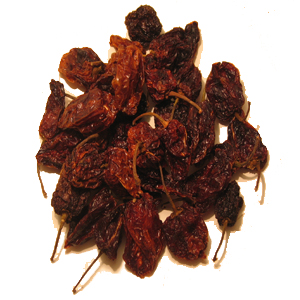|
Generally speaking, chipotle in English refers to any smoked chile pepper. The Spanish word chipotle is a contraction of chilpotle in the Náhuatl language of the Aztecs, where chil referred to the hot pepper and potle was derived from poctli, meaning smoked. The word was apparently reversed from Náhuatl, where it originally was spelled pochilli. Other early spellings in Mexico are tzilpoctil, tzonchilli, and texochilli.
|
By Dave DeWitt and Chuck Evans
 |
RecipesChipotles Adobados (Chipotle Chiles in Adobo Sauce)Smoky Mayonnaise
|
|
Generally speaking, chipotle in English refers to any smoked chile pepper. The Spanish word chipotle is a contraction of chilpotle in the Náhuatl language of the Aztecs, where chil referred to the hot pepper and potle was derived from poctli, meaning smoked. The word was apparently reversed from Náhuatl, where it originally was spelled pochilli. Other early spellings in Mexico are tzilpoctil, tzonchilli, and texochilli. Origins Smoked chiles had their origin in the ancient civilization of Teotihuacan, north of present-day Mexico City. It was the largest city-state in Mesoamerica and flourished centuries before the rise of the Aztecs. Chipotles also made an appearance in the marketplaces of Tenochtitlán, the capital city of the Aztecs that is now called Mexico City. Certain varieties of fleshy chiles, now called jalapeños, would not dry properly in the sun–their thick flesh would rot first. However, like meats, they could be preserved by the process known as smoke-drying.
History Bernardino de Sahagún, a Spanish friar who lived in Mexico in the early 1500s, described a dish called teatzin which was served in Cholula in the state of Puebla. It contained a combination of chipotle and pasilla sauces for stewing fresh jalapeños and lenten palm flowers. In 1575, a Spanish visitor to Mexico, Juan de la Cueva, described a dish that combined the seedless chipotles (capones), onions, piñon nuts, and a broth with meat juice and pulque (agave beer). The sauce was simmered with chunks of meat to create pipián de piñon. For hundreds of years after the Aztecs, smoked chiles were found predominantly in the markets of Central and South Mexico, such as Puebla, Oaxaca, Veracruz, and Chiapas. In Huatasco in the state of Veracruz, a salsa called tlatonile made with tomatoes, peanuts, and chipotles has been made for centuries.
|
|||
|
Varieties
The classic chipotle, Típico, is grayish-tan, quite stiff, and is often described as looking like a cigar butt. It is deeply imbued with smoke and is both hot and flavorful. This main variety is also called chile ahumado (smoked chile); chile meco (blackish-red chile; meco is close to seco, meaning dry); the double terms chipotle meco and chipotle típico, and just típico. Further confusing the issue is a cultivated variety of jalapeño that is also named ‘Típico.’ Yes, the ‘Tipico’ variety is often smoked to become a típico chipotle.
Other varieties of smoked jalapeños are often mistaken for the típico chipotle. The most common one is called Morita, at left, which means “little blackberry” in Spanish. The color of this smoked chile is dark red, sometimes approaching purple in color. Often the morita is referred to as a smoked serrano chile, but this is inaccurate. Both the típico and the morita are smoked jalapeños; the difference is that the morita is not smoked nearly as long, and thus it remains very leathery and pliable. Not only is the smoky flavor much more intense in the típico, its flavor is much richer. But the morita is commonly marketed as the típico chipotle because it can bring $2 to $4 more per pound with that name. Unfortunately, most of the “chipotles” being sold in markets in the United States are in actuality the inferior moritas. This is because most of the chipotles produced in Mexico are eaten there, leaving little for export. To make up for lack of the típico variety to export, producers in the northern states of Mexico, particularly Chihuahua, have turned to the moritas, which are much less expensive to produce. Unfortunately, they call the moritas “chipotles” and sometimes claim that they have never heard of the típico variety. To further confuse the issue, in the interior, the típico is known by brokers as ‘Veracruz’.
|
|||
|
Other varieties of smoked chiles include:
Pasilla de Oaxaca: a variety of pasilla chile that is smoked in Oaxaca and is used in the famous mole negro.
Habanero: smoked habanero products have been introduced into the United States by a few manufacturers. They are used as a very hot substitute for any chipotle product.
Jalapeño chico: jalapeños that are smoked while still green. Usually, they are culls from the fresh market that need to be preserved, and the smoke-drying process obscures any blemishes. Our series sponsor, Chipotle Texas, offers even more varieties of smoked chiles. Click on the banner above to view choices of whole pods, powders, and flakes of the following varieties: pequins, serranos, and mild red New Mexican. Pages: 1 2
|










